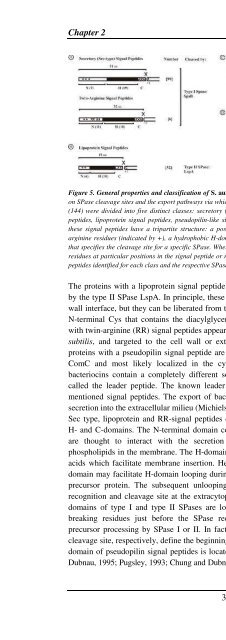The Staphylococcus aureus secretome - TI Pharma
The Staphylococcus aureus secretome - TI Pharma
The Staphylococcus aureus secretome - TI Pharma
Create successful ePaper yourself
Turn your PDF publications into a flip-book with our unique Google optimized e-Paper software.
Chapter 2<br />
Figure 5. General properties and classification of S. <strong>aureus</strong> signal peptides. Signal peptide properties are based<br />
on SPase cleavage sites and the export pathways via which the preproteins are exported. Predicted signal peptides<br />
(144) were divided into five distinct classes: secretory (Sec-type) signal peptides, twin-arginine (RR/KR) signal<br />
peptides, lipoprotein signal peptides, pseudopilin-like signal peptides, and bacteriocin leader peptides. Most of<br />
these signal peptides have a tripartite structure: a positively charged N-domain (N), containing lysine and/or<br />
arginine residues (indicated by +), a hydrophobic H-domain (H, indicated by a black box), and a C-domain (C)<br />
that specifies the cleavage site for a specific SPase. Where appropriate, the most frequently occurring amino acid<br />
residues at particular positions in the signal peptide or mature protein are indicated. Also, the numbers of signal<br />
peptides identified for each class and the respective SPase are indicated.<br />
<strong>The</strong> proteins with a lipoprotein signal peptide are lipid-modified by Lgt, prior to processing<br />
by the type II SPase LspA. In principle, these lipoproteins are retained at the membrane-cell<br />
wall interface, but they can be liberated from this compartment by proteolytic removal of the<br />
N-terminal Cys that contains the diacylglyceryl moiety (Antelmann et al., 2001). Proteins<br />
with twin-arginine (RR) signal peptides appear to be processed by type I SPases, at least in B.<br />
subtilis, and targeted to the cell wall or extracellular milieu (Tjalsma et al., 2004). <strong>The</strong><br />
proteins with a pseudopilin signal peptide are processed by the pseudopilin signal peptidase<br />
ComC and most likely localized in the cytoplasmic membrane and cell wall. Finally,<br />
bacteriocins contain a completely different sorting and modification signal that is usually<br />
called the leader peptide. <strong>The</strong> known leader peptides show no resemblance to the aforementioned<br />
signal peptides. <strong>The</strong> export of bacteriocins via ABC-transporters results in their<br />
secretion into the extracellular milieu (Michiels et al., 2001; Schnell et al., 1988).<br />
Sec type, lipoprotein and RR-signal peptides contain three distinguishable domains: the N-,<br />
H- and C-domains. <strong>The</strong> N-terminal domain contains positively charged amino acids, which<br />
are thought to interact with the secretion machinery and/or with negatively charged<br />
phospholipids in the membrane. <strong>The</strong> H-domain is formed by a stretch of hydrophobic amino<br />
acids which facilitate membrane insertion. Helix-breaking residues in the middle of the Hdomain<br />
may facilitate H-domain looping during membrane insertion and translocation of the<br />
precursor protein. <strong>The</strong> subsequent unlooping of the H-domain would display the SPase<br />
recognition and cleavage site at the extracytoplasmic membrane surface where the catalytic<br />
domains of type I and type II SPases are localized (van Roosmalen et al., 2004). Helixbreaking<br />
residues just before the SPase recognition and cleavage site would facilitate<br />
precursor processing by SPase I or II. In fact, these helix-breaking residues and the SPase<br />
cleavage site, respectively, define the beginning and the end of the C-domain. Notably, the Cdomain<br />
of pseudopilin signal peptides is located between the N- and H-domains (Chung and<br />
Dubnau, 1995; Pugsley, 1993; Chung and Dubnau, 1998; Lory, 1998). Accordingly, processing<br />
36













